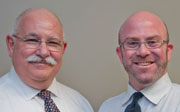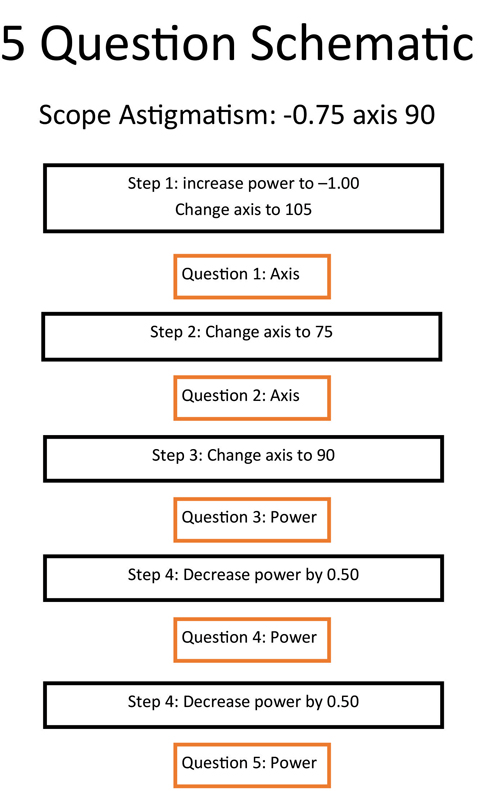 |
Which is better, one or two?” You’ve probably heard that repeated back to you at parties any time you mention what you do for a living. But you know it’s more than a catchphrase; it represents the astigmatic portion of a patient’s refraction. You also know that it can be a real time thief. This month, we identify several steps you can take to save time on refractions from start to finish, without ignoring that vital refractive data, so you can get out of the exam lane and back to the party.
Get Out Your Retinoscope
Any refraction’s foundation comes from a retinoscopy exam. Obtaining this starting point accurately sets the stage for the most efficient refraction, particularly in the portion of the refraction where we address astigmatism. We tell our students that, for every 20 seconds you spend getting a good starting point for the refraction with your retinoscopy, you may save two minutes.
When working with novices at retinoscopy, consider these two points: (1) Make sure they move only the retinoscope. Some of our students tend to bob their head up and down or side-to-side to move the retinoscopy light through the pupil. This actually makes the assessment more difficult. The key is to stay steady in space and pivot the scope off the forehead for both movements. (2) When scoping axes which are away from 90 or 180, make sure they rotate the scope. To shift the scope up and down through axis 90, the bottom is moved slightly away from the chin and towards the chin. A common mistake is to move the light either too far or too fast to make the direction of the movement easy to see. This is one of those instances when slowing down can actually speed up the entire process.
Start by getting the reflex centered and stable. As you move the bottom of the retinoscope slowing towards or away from your chin, you should be able to note the direction of movement before you complete even a half of a cycle. The second movement is a pure twist of the hand, rotating the retinoscope along its long axis. After getting things settled, a smooth slow rotation of the scope should allow you to see the direction of movement before you complete even half a cycle.
With regards to those off-axis cylinders, I don’t know too many people who can adjust the collar to axis 120, keep the handle straight up and down and perform the movement necessary to move the light purely through the axis 120 meridian. A simpler method is to keep the collar orthogonal to the scope itself and to rotate the arm to axis 120, keeping the top of the scope against the forehead. The physical movements then remain the same. To get axis 120, move the bottom of the scope away and towards the lower part of your face, but do so directly along the axis of the scope itself. To scope the opposite axis, perform the same twisting motion of the scope along the axis of the scope itself.
 |
| Focusing on ways to streamline aspects of your astigmatic refraction exam can help you see more patients in less time. Click image to enlarge. |
Choosing a JCC Power
Ever wonder how the +/- 0.25 Jackson Cross Cylinder (JCC) became so widely accepted as the best choice? The old Bausch & Lomb Greens Phoropter came with a set of auxiliary lenses, which included three powers of JCC lenses; +/- 0.25, 0.37, and 0.50 which could be easily swapped in and out as needed.
Having used the Greens in practice for many years, we found the +/- 0.50 allowed for faster refinement of both the cylinder axis and power than either of the other two powers. The differences between choices one and two were simply bigger and easier to see. Does the smaller power JCC allow for more refined refractive endpoints? In our experience, only in a very small percentage of patients we see. For most, the +/- 0.25 JCC does not make a big enough difference between the choices for them to detect or report actual differences and we find it is actually more time consuming as patients incessantly ask to review the options again. We recommend +/- 0.50 JCC lenses.
The Five Questions
Set a goal to see if you can do this testing with a maximum of five questions. When you achieve this, you will know that your scope gave you a great starting place and the differences you were showing your patient were big enough for them to make simple and swift choices.
Say, for instance, you have scoped a cylinder of -0.75 at axis 90 and have confirmed that the sphere power is at the right level of accommodative stimulus to begin your cylinder testing. Let us also assume that we are not dealing with someone having worse best-corrected visual acuity of 20/20 for the sake of working through these routines. In this case, we suggest a single 20/40 line be the target.
Here are the steps and the questions we would ask this patient. Note that what you see in the parentheses below is not to be said aloud, but is to help you understand what we are asking based on the optics.
Step 1: Increase the cylinder power to -1.00 and turn the axis to 105. Set the JCC to test for AXIS.
Question 1: Which is better, this way “1” (towards where I scoped) or this way “2” (away from where I scoped)?
Patient: Towards.
Step 2: Turn the axis to 75. Test for AXIS.
Question 2: Which is better, this way “1” (towards where I scoped) or this way “2” (away from where I scoped)?
Patient: Towards.
Step 3: Turn the axis back to 90 and set the JCC to test for POWER
(Remember the power of the cylinder is -0.25 higher than what we scoped.)
Question 3: Which is better, this way “1” (more than more than what I scoped) or this way “2” (less than more than what I scoped)?
Patient: Less.
Step 4: Reduce the power of the cylinder by 0.50, from -1.00 to -0.50, in this example
Question 4: Which is better, this way “1” (less than less than what I scoped) or this way “2” (more than less than what I scoped)?
Patient: More.
Step 5: Since we now know that the axis of this small cylinder is between 75 and 105, and the power is less than -1.00 and more than -0.50, we can increase the power of the cylinder by 0.25, from -0.50 to -0.75, in this example
Question 5: Which is better, this way “1” (less than what I scoped) or this way “2” (more than what I scoped)?
Cylinder Exchange
If in answering these questions the patient hesitates, you can assume the two choices look similar. To us, this is not evidence that the power needs to be higher, they have not earned the -0.75 so we go back down to -0.50 and move on.
If the patient quickly says that the “less than what I scoped” option is better, we also drop down to the -0.50 and move on. If, and only if, rather quickly, at the same speed or only slightly slower than the previous four responses, the patient responds that the “more than what I scoped” option was better, we kick the cylinder back up to -0.75 and move on.
With higher-power cylinders, we move the initial testing axis away from our scoped axis less. For example, with a -2.50 cylinder, we may shift the axis only +/- 5 degree to either side of where we scoped the patient.
If some of the ideas here are new to you, give them a try and see if you can get to your endpoints faster and still prescribe with confidence.

